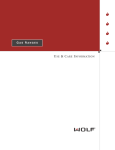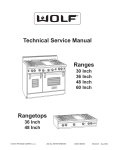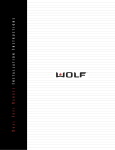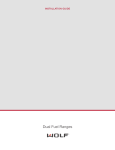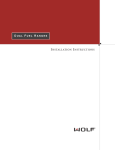Download Wolf 1524 Specifications
Transcript
GAS RANGES I NSTALLATION I NSTRUCTIONS C O N TA C T I N F O R M AT I O N Wolf Customer Service: 800-332-9513 Website: wolfappliance.com As you follow these instructions, you will notice WARNING and CAUTION symbols. This blocked information is important for the safe and efficient installation of Wolf equipment. There are two types of potential hazards that may occur during installation. signals a situation where minor injury or product damage may occur if you do not follow instructions. states a hazard that may cause serious injury or death if precautions are not followed. Another footnote we would like to identify is IMPORTANT NOTE: This highlights information that is especially relevant to a problemfree installation. WOLF ® is a registered trademark of Wolf Appliance Company, Inc. WO L F GAS RANGES I N S TA L L AT I O N R E Q U I R E M E N T S IMPORTANT NOTE: This installation must be completed by a qualified installer, service agency or gas supplier. IMPORTANT NOTE: Save these Installation Instructions for the local inspector’s use. Please read the entire Installation Instructions prior to installation. Installer: please retain these instructions for local inspector’s reference, then leave them with the homeowner. Homeowner: please read and keep these instructions for future reference and be sure to read the entire Use & Care Information prior to use. IMPORTANT NOTE: This appliance must be installed in accordance with National Electrical Codes, as well as all state, municipal and local codes. The correct voltage, frequency and amperage must be supplied to the appliance from a dedicated, grounded circuit which is protected by a properly sized circuit breaker or time delay fuse. The proper voltage, frequency, and amperage ratings are listed on the product rating plate. Record the model and serial numbers before installing the gas range. Both numbers are listed on the rating plate, located under the drip pan that supports the cooking grates, on the left inside wall of the range. Refer to the illustration below. The rating plate for Model R482CF is located on the right inside wall. Location of rating plate on the inside wall If the information in this book is not followed exactly, a fire or explosion may result, causing property damage, personal injury or death. R AT I N G P L AT E I N F O R M AT I O N Model Number IMPORTANT NOTE: Installation and service must be performed by a qualified installer, service agency or the gas supplier. Serial Number Warranty service must be performed by a Wolf authorized service center. Do not store or use gasoline or other flammable vapors and liquids in the vicinity of this or any other appliance. A ventilation hood is recommended for use with the Wolf gas range. WHAT TO DO IF YOU SMELL GAS: Do not try to light any appliance. Do not touch any electrical switch. Do not use any phone in your building. Immediately call your gas supplier from a neighbor’s phone. Follow the gas supplier’s instructions. If you cannot reach your gas supplier, call the fire department. Rating plate location This range can tip. Injury to persons could result. Install the anti-tip device packaged with this range according to instructions on page 11. 3 WO L F GAS RANGES B E F O R E YO U S TA RT Proper installation is your responsibility. Installations must be performed by a qualified or licensed contractor, plumber or gas fitter, qualified or licensed by the state, province or region where this appliance is being installed. You must also assure that electrical installation is adequate and conforms with all local codes and ordinances. Wolf gas ranges are manufactured for use with natural gas or LP gas. Please check the product rating plate for type of gas needed. Proper gas connection must be available; refer to Gas Supply Requirements on pages 12–13. Electrical ground is required; see Electrical Requirements on page 14. Check the location where the range will be installed. The location should be away from strong draft areas, such as windows, doors and strong heating vents or fans. Do not obstruct the flow of air. The area in which you are installing this appliance must have an adequate supply of fresh air to ensure proper combustion and ventilation. Make sure you have everything necessary for correct installation. It is the responsibility of the installer to comply with the specified installation clearances. Refer to the Installation Specifications illustrations for your model on pages 7–10. 4 C O M M O N W E A LT H O F M A S S A C H U S E T T S Installations and repairs must be performed by a qualified or licensed contractor, plumber or gasfitter qualified or licensed by the state, province, or region where this appliance is being installed. Only use gas shut-off valves approved for use within the state, province, or region where this appliance is being installed. A flexible gas connector, when used, must not exceed 3' (.9 m). I N S TA L L AT I O N I N S T R U C T I O N S V E N T I L AT I O N C O N S I D E R A T I O N S V E N T I L AT I O N O P T I O N S The front of your Wolf gas range must be clear of any obstruction. For proper operation and servicing, a clear area of at least 36" (914) in front of the range is recommended. IMPORTANT NOTE: It is recommended that you operate the Wolf gas range with a Pro ventilation hood. Contact your Wolf dealer for details. Your kitchen must provide an adequate supply of fresh air to assure proper combustion and ventilation. Pro Wall Hood – 22" (559), 24" (610) or 27" (686) depths and 30" (762) to 66" (1676) widths in classic stainless steel. For the gas range, fresh air intakes are located below the bullnose and control knobs. For the oven burner, there are fresh air intakes at the bottom front of the kick panel. Never block the fresh air intakes, as they provide air required for proper operation. Refer to the illustration. Pro Island Hood – 36" (914) to 66" (1676) widths in classic stainless steel. Most of the heated air and burner combustion by-products from the oven(s) exit through the back stainless steel riser. Gas ranges can be used with the optional island trim or 5" (127), 10" (254), or 20" (508) risers available through your Wolf dealer. Due to the high volume of ventilation air required, a source of outside replacement air is recommended. This is particularly important for tightly sealed and insulated homes. A qualified HVAC contractor should be consulted. Pro Hood Liner – available in widths to accommodate 30" (762) to 60" (1524) hood shells. All Pro ventilation hoods have welded seams, sealed halogen lighting and removable, dishwasher-safe stainless steel filters. ACCESSORIES Optional accessories are available through your Wolf dealer. To obtain local dealer information, visit the Locator section of our website, wolfappliance.com. Blower requirements may vary due to length of duct work and number of angles. The basic recommendation is 1 CFM per 100 Btu/hr. Always consult your HVAC professional for more concise blower requirements. IMPORTANT NOTE: When installing a ventilation hood, refer to the specific requirements of the hood for the minimum dimension to countertop. Keep combustibles such as solvents, cleaning fluids, mops and rags, away from the area surrounding all gas appliances. Heated Air Exits Air Intake Air Intake Ventilation requirements Dimensions in parentheses are in millimeters unless otherwise specified. 5 WO L F GAS RANGES I N S TA L L AT I O N S P E C I F I C AT I O N S MINIMUM CLEARANCES I S L A N D | P E N I N S U L A I N S TA L L A T I O N S IMPORTANT NOTE: Caution must be used in planning the proper installation of the Wolf gas range to avoid fires or damage to adjacent cabinetry or kitchen equipment. Be sure to follow the minimum clearances established in the finished rough opening dimensions. Minimum clearances to combustible surfaces: Refer to the Installation Specifications illustrations for your model on pages 7–10 for the exact rough opening dimensions. W A L L I N S TA L L A T I O N S Minimum clearances to combustible surfaces: A minimum clearance of 18" (457) must be maintained between the countertop and the bottom of overhead side cabinets or other combustible materials. Gas range: 6" (152) minimum clearance from side walls, 0" (0) from rear wall. Gas range with hood: 0" (0) from side cabinets, 18" (457) minimum clearance above countertop, 0" (0) from rear wall. 0" (0) clearance for adjacent combustible materials below the countertop, both sides and rear. The maximum depth of adjacent overhead side cabinets is 13" (330). Minimum clearances for gas ranges without a ventilation hood: Minimum vertical distance between the surface burners or griddle to combustible materials above the gas range must be 30" (762). Minimum vertical distance between the charbroiler (some models) to combustible materials above the gas range must be 36" (914). For all 60" (1524) models, the minimum vertical clearance between the gas range and combustible materials above the range is 44" (1118). 6 For island installations, the range should not be installed within an enclosure having an adjacent rear wall less than 12" (305) from the rear of the unit that rises above the countertop. For peninsula installations, the range must have a 6" (152) minimum clearance to the side wall, left or right side, and 12" (305) minimum clearance to the rear wall. Refer to the Installation Specifications illustrations for your model on pages 7–10 for the exact rough opening dimensions. Failure to locate the range without the proper clearances will result in a fire hazard. I N S TA L L AT I O N I N S T R U C T I O N S 30" (762) G A S R A N G E 28 3/8" (721) OVERALL DEPTH 27 1/4" (692) 9 1/4" (235) 56 3/4" (1441) WITH 20" RISER 24 1/2" (622) 46 3/4" (1187) WITH 10" RISER 37" (940) 36" OVERALL HEIGHT TO COOKING SURFACE (914) OVERALL DIMENSIONS Overall Width 30" (762) Overall Height (to cooking surface) 37" (940) 41 3/4" (1060) WITH 5" RISER Overall Depth 28 3/8" (721) Opening Width 30 1/4" (768) Unit dimensions may vary by ± 1/8" (3). 2 1/2" (64) 30" (762) OVERALL WIDTH 25 1/4" (641) 43 3/8" (1102) LEGS AND CASTERS ALLOW 1" (25) HEIGHT ADJUSTMENT I N S TA L L AT I O N S P E C I F I C AT I O N S IMPORTANT NOTE: A minimum 5" (127) riser is required when installing a 30" (762) gas range against a combustible surface. VENTILATION HOOD 30"min (762) COUNTERTOP TO COMBUSTIBLE MATERIALS 13" max 30"(762) TO 36"(914) (330) COUNTERTOP TO BOTTOM OF VENTILATION HOOD 6" min (152) TO COMBUSTIBLE MATERIALS (BOTH SIDES) 18"min (457) TO COUNTERTOP 301/4" (768) FINISHED ROUGH OPENING WIDTH 10" 12" (254) (305) 8" (203) E 36" (914) 37" (940) TO COOKING SURFACE 2" (51) 51/2" (140) G 12" 5" (305) (127) 3" LOCATION OF GAS SUPPLY EXTENDS 3" (76) ON FLOOR FROM BACK WALL (76) ISLAND INSTALLATIONS: 12" (305) MINIMUM CLEARANCE FROM BACK OF RANGE TO COMBUSTIBLE REAR WALL ABOVE COUNTERTOP – 0" (0) TO NON-COMBUSTIBLE MATERIALS Dimensions in parentheses are in millimeters unless otherwise specified. 7 WO L F GAS RANGES 36" (914) G A S R A N G E S 28 3/8" (721) OVERALL DEPTH 27 1/4" (692) 9 1/4" (235) 56 3/4" OVERALL DIMENSIONS Overall Width 36" (914) Overall Height (to cooking surface) 37" (940) Overall Depth 28 3/8" (721) Opening Width 36 1/4" (921) (1441) WITH 20" RISER 46 3/4" (1187) WITH 10" RISER 24 1/2" (622) 36" 37" (940) OVERALL HEIGHT TO COOKING SURFACE 41 3/4" (1060) WITH 5" RISER (914) Unit dimensions may vary by ± 1/8" (3). 2 1/2" (64) 25 1/4" (641) 36" (914) OVERALL WIDTH 43 3/8" (1102) LEGS AND CASTERS ALLOW 1" (25) HEIGHT ADJUSTMENT I N S TA L L A T I O N S P E C I F I C AT I O N S IMPORTANT NOTE: A minimum 5" (127) riser is required when installing a gas range against a combustible surface. A minimum 10" (254) riser is required when installing a gas range with a charbroiler or griddle against a combustible surface. VENTILATION HOOD 30"min (762) COUNTERTOP TO COMBUSTIBLE MATERIALS 13" max 36"min (914) 30"(762) TO 36"(914) 6" min (152) TO COMBUSTIBLE MATERIALS (BOTH SIDES) FOR CHARBROILER (330) COUNTERTOP TO BOTTOM OF VENTILATION HOOD 18"min (457) TO COUNTERTOP 361/4" (921) FINISHED ROUGH OPENING WIDTH 36" (914) 10" 12" (254) (305) 8" (203) 37" (940) TO COOKING SURFACE E 2" (51) 51/2" (140) G 12" 5" (305) (127) ISLAND INSTALLATIONS: 12" (305) MINIMUM CLEARANCE FROM BACK OF RANGE TO COMBUSTIBLE REAR WALL ABOVE COUNTERTOP – 0" (0) TO NON-COMBUSTIBLE MATERIALS 8 3" LOCATION OF GAS SUPPLY EXTENDS 3" (76) ON FLOOR FROM BACK WALL (76) I N S TA L L AT I O N I N S T R U C T I O N S 48" (1219) G A S R A N G E S 28 3/8" (721) OVERALL DEPTH 27 1/4" (692) 9 1/4" (235) 56 3/4" OVERALL DIMENSIONS (1441) WITH 20" RISER Overall Width 46 3/4" 24 1/2" (622) (1187) WITH 10" RISER 37" (940) 36" OVERALL HEIGHT TO COOKING SURFACE (914) 48" (1219) Overall Height (to cooking surface) 41 3/4" (1060) WITH 5" RISER Overall Depth Opening Width 37" (940) 28 3/8" (721) 48 1/4" (1226) Unit dimensions may vary by ± 1/8" (3). 2 1/2" (64) 25 1/4" (641) 48" (1219) OVERALL WIDTH 43 3/8" (1102) LEGS AND CASTERS ALLOW 1" (25) HEIGHT ADJUSTMENT I N S TA L L AT I O N S P E C I F I C AT I O N S IMPORTANT NOTE: A minimum 5" (127) riser is required when installing a gas range against a combustible surface. A minimum 10" (254) riser is required when installing a gas range with a charbroiler or griddle against a combustible surface. VENTILATION HOOD 30"min (762) COUNTERTOP TO COMBUSTIBLE MATERIALS 6" min (152) TO COMBUSTIBLE MATERIALS (BOTH SIDES) 30"(762) TO 36"(914) 13" max COUNTERTOP TO BOTTOM OF VENTILATION HOOD 36"min (914) FOR CHARBROILER (330) 18"min (457) TO COUNTERTOP 481/4" (1226) FINISHED ROUGH OPENING WIDTH 36" (914) 26" 12" (660) (305) 8" (203) 37" (940) TO COOKING SURFACE E 2" (51) 51/2" (140) G 12" 5" (305) (127) 3" LOCATION OF GAS SUPPLY EXTENDS 3" (76) ON FLOOR FROM BACK WALL (76) ISLAND INSTALLATIONS: 12" (305) MINIMUM CLEARANCE FROM BACK OF RANGE TO COMBUSTIBLE REAR WALL ABOVE COUNTERTOP – 0" (0) TO NON-COMBUSTIBLE MATERIALS Dimensions in parentheses are in millimeters unless otherwise specified. 9 WO L F GAS RANGES 60" (1524) G A S R A N G E S 28 3/8" (721) OVERALL DEPTH 27 1/4" (692) 9 1/4" (235) 56 3/4" OVERALL DIMENSIONS Overall Width Overall Height (to cooking surface) Overall Depth Opening Width (1441) WITH 20" RISER 60" (1524) 46 3/4" 24 1/2" (622) 37" (940) OVERALL HEIGHT TO COOKING SURFACE 37" (940) 28 3/8" (721) (1187) WITH 10" RISER 36" 41 3/4" (1060) WITH 5" RISER (914) 60 1/4" (1530) Unit dimensions may vary by ± 1/8" (3). 2 1/2" (64) 25 1/4" (641) 60" (1524) OVERALL WIDTH 43 3/8" (1102) LEGS AND CASTERS ALLOW 1" (25) HEIGHT ADJUSTMENT I N S TA L L A T I O N S P E C I F I C AT I O N S IMPORTANT NOTE: A minimum 5" (127) riser is required when installing a gas range against a combustible surface. A minimum 10" (254) riser is required when installing a gas range with a charbroiler or griddle against a combustible surface. VENTILATION HOOD 6" min (152) TO COMBUSTIBLE MATERIALS (BOTH SIDES) 44"min (1118) COUNTERTOP TO COMBUSTIBLE MATERIALS 30"(762) TO 36"(914) 13" max COUNTERTOP TO BOTTOM OF VENTILATION HOOD (330) 18"min (457) TO COUNTERTOP 601/4" (1530) FINISHED ROUGH OPENING WIDTH 36" (914) 10" 12" (254) (305) 8" (203) 37" (940) TO COOKING SURFACE E 2" (51) 51/2" (140) ISLAND INSTALLATIONS: 12" (305) MINIMUM CLEARANCE FROM BACK OF RANGE TO COMBUSTIBLE REAR WALL ABOVE COUNTERTOP – 0" (0) TO NON-COMBUSTIBLE MATERIALS 10 G 12" 5" (305) (127) 3" LOCATION OF GAS SUPPLY EXTENDS 3" (76) ON FLOOR FROM BACK WALL (76) I N S TA L L AT I O N I N S T R U C T I O N S U N PAC K T H E R A N G E M OV I N G T H E R A N G E Remove and discard all packing materials, including cardboard and tape on the outside of the range and inside the oven cavity. IMPORTANT NOTE: Before moving the range, protect any finished flooring with appropriate materials to avoid damage to the floor. IMPORTANT NOTE: Do not discard the anti-tip bracket packed with the range. Due to the weight, a dolly with soft wheels should be used to move your Wolf gas range. The weight must be supported uniformly across the bottom. ANTI-TIP B R AC K E T This range can tip. Injury to persons could result. Install the anti-tip bracket packed with the range. Follow these installation instructions. The rear channel brace is preinstalled at the factory. Mount the anti-tip bracket at 6 1/2" (165) minimum from floor. If the range legs are adjusted higher than the 3" (76) minimum, the anti-tip bracket must be raised accordingly. Push the range back until it is flush with the wall to engage the anti-tip bracket. The maximum gap between the anti-tip bracket and the rear channel brace should not exceed 1/4" (6). Refer to the illustration below. WALL Move the range by dolly close to its installation location. The range can be tipped back and supported on the rear casters while the dolly is carefully removed. Be sure to protect the flooring underneath the casters. Gas and electrical connections should be made and the backsplash and/or riser installed before the range is placed in its final position. Do not lift the range by the oven door handle(s). This will damage the oven door and hinges. SIDE PANEL ANTI-TIP BRACKET REAR CHANNEL BRACE 6 1/2" (165mm) MIN TO FLOOR FLOOR Anti-tip bracket installation Dimensions in parentheses are in millimeters unless otherwise specified. 11 WO L F GAS RANGES OV E N D O O R R E M O V A L Failure to insert the hinge pin in the appropriate hinge arm will cause damage to the range. Minor injuries may occur. IMPORTANT NOTE: The oven door(s) should not be removed unless it is necessary to fit the range through a tight doorway. Door removal should only be done by a qualified service technician or installer. Door removal and reinstallation may cause damage to the porcelain interior of the oven or door(s). If removal of the oven door(s) is necessary, a hinge pin, supplied with the range, will need to be inserted in the appropriate hinge arm. For each oven door, only one hinge arm is spring loaded, requiring use of the hinge pin for removal of the oven door. The hinge pin will be found taped to the inside of the oven door. For 30" (762) and 36" (914) gas ranges, the hinge pin will be inserted through the hole in the right hinge arm (facing the unit). On 48" (1219) and 60" (1524) gas ranges, the spring hinges are located on the outer edges of the unit. On these units, the left oven door will have the spring hinge on the left side and the right oven door will have the spring hinge on the right side. Refer to the illustrations below for the location of the spring hinge(s) for your specific model. If removal of the oven door(s) is necessary, follow these steps: 1) Open the oven door to its fully opened position and insert the supplied door hinge pin through the hole in the appropriate hinge arm. Refer to the illustration below. 2) Remove both upper and lower hinge retainer mounting screws. NOTE: The oven gasket may have to be moved slightly to access the bottom screws. 3) After removing the mounting screws, move the hinge retainer plate forward slightly. NOTE: The hinge retainer plate will remain on the door hinge assembly after the mounting screws have been removed. 4) Carefully close the oven door to about a 60° angle from horizontal and lift the door away from the oven. NOTE: A slight racking motion may be required for removal. 5) For 48" (1219) and 60" (1524) gas ranges, complete these steps for both oven doors. Do not lift or carry the oven door by the door handle. Hinge Retainer Plate Upper Mounting Screw Hinge Pin Place Hinge Pin on Spring Hinge Side of Door Spring hinge location for 30" (762) and 36" (914) gas ranges 12 Place Hinge Pins on Spring Hinge Side of Door Spring hinge locations for 48" (1219) and 60" (1524) gas ranges Kickplate Oven door removal I N S TA L L AT I O N I N S T R U C T I O N S LEVEL T H E R A N G E IMPORTANT NOTE: The top of the range must be level. Use both the adjustable front legs and the adjustable rear casters to level the range. The 3" (76) front legs are adjusted by rotating the bottom hexagonal portion of the leg. The rear casters can be adjusted by rotating the 2 5/16" (59) nut on the caster. The range legs and casters allow for a 1" (25) upward height adjustment. Using the supplied wrench, rotate the nut clockwise to raise the unit or counterclockwise to lower the unit. Refer to the illustration below. REAR CASTER ADJUSTMENT NUT HEIGHT ADJUSTMENT WITH SUPPLIED WRENCH Rear caster adjustment Dimensions in parentheses are in millimeters unless otherwise specified. 13 WO L F GAS RANGES G A S S U P P LY R E Q U I R E M E N T S G A S S U P P LY C O N N E C T I O N EXPLOSION HAZARD — Use a certified gas supply line and install a gas shut-off valve. I M P O RTA N T N OT E This installation must conform with local codes and ordinances. In the absence of local codes, installations must conform with the American National Standard, National Fuel Gas Code. Securely tighten all gas connections. The maximum gas supply pressure to the regulator should never exceed 14" (34.9 mb) WC (water column); .5 psi (3.5 kPa). Failure to do so can result in explosion, fire or death. TYPES OF GAS There are two types of gas, natural and liquid propane (LP). Conversions are required in order for appliances designed for one gas to be operated with the other gas. Such conversions must be performed by a Wolf authorized service center. Make sure your gas range is correctly adjusted for the type of gas being used. The product rating plate has information on the type of gas that should be used. If this information does not agree with the type of gas available, check with the local gas supplier. The rating plate is located under the drip pan that supports the cooking grates, on the left inside wall of the range. Refer to the illustration on page 3. The rating plate for Model R482CF is located on the right inside wall. IMPORTANT NOTE: The gas range must be connected to a regulated gas supply. Provide a gas supply line of 3/4" rigid pipe to the range location. A smaller size pipe on long runs may result in insufficient gas supply. Pipe joint compounds, suitable for use with LP gas should be used. For LP gas, piping or tubing size can be 1/2" minimum. LP gas suppliers usually determine the size and materials used on the system. If local codes permit, a certified, 3' (.9 m) long, 1/2" or 3/4" ID flexible metal appliance connector is recommended for connecting this range to the gas supply line. The pipe coming out the back of the range has 1/2" female threads. IMPORTANT NOTE: The supply line must be equipped with an approved external gas shut-off valve located near the range in an accessible location. Do not block access to the shut-off valve. Refer to the illustration below. The Wolf gas range functions up to 6,000' (1828 m) in altitude without any adjustment. If installation is above 6,000' (1828 m), contact your Wolf dealer. SHUT-OFF VALVE Open Position To Appliance Shut-off valve 14 Gas Supply Line I N S TA L L AT I O N I N S T R U C T I O N S G A S S U P P LY R E Q U I R E M E N T S GAS LEAK TESTING Before connecting the gas supply, make sure all valves are in a closed position. Do not connect the gas supply to an appliance that shows any sign of physical damage. Use a brush and liquid detergent to test all gas connections for leaks. Bubbles around connections will indicate a leak. If a leak appears, shut off the gas valve and adjust connections. Then check connections again. Clean all the detergent solution from the range. GAS MANIFOLD PRESSURE For Natural Gas: Standard orifices are set for 5" (12.5 mb) WC (water column). A natural gas pressure regulator is installed. Never test for a gas leak with a match or other flame. For Propane (LP) Gas: Standard orifices are set for 10" (25 mb) WC (water column). A propane gas pressure regulator is installed. Gas Supply Pressure: For checking the regulator setting, the maximum line pressure for natural and propane (LP) gas: 14" (34.9 mb) WC; .5 psi (3.5 kPa). Minimum line pressure for natural gas: 7" (17.5 mb) WC. Minimum line pressure for propane (LP) gas: 11" (27.4 mb) WC. Gas Supply Regulator: To control and maintain a uniform gas pressure in the gas manifold, the unit must be used with a gas pressure regulator. The burner orifices, etc. are sized for the gas pressure delivered by the supplied regulator. Do not remove the regulator. The maximum gas supply pressure to the regulator should never exceed 14" (34.9 mb) WC; .5 psi (3.5 kPa). Dimensions in parentheses are in millimeters unless otherwise specified. 15 WO L F GAS RANGES ELECTRICAL R E Q U I R E M E N T S R E C O M M E N D E D G RO U N D M E T H O D ELECTRICAL SHOCK HAZARD – Plug into a grounded 3-prong outlet. I M P O RTA N T N OT E You must follow all National Electrical Code regulations. In addition, be aware of local codes and ordinances when installing your service. Do not remove ground prong. Do not use an adapter. Failure to follow these instructions can result in electric shock, fire or death. The Wolf gas range requires a 110/120 V AC electrical supply to operate the electronic ignition system. The 6' (1.8 m) power supply cord provided with the range is equipped with a 3-prong, grounded plug for protection against shock hazard. The service should have its own 15 amp circuit breaker. IMPORTANT NOTE: You must follow all National Electrical Code and gas regulations. In addition, be aware of local codes and ordinances when installing your services. IMPORTANT NOTE: This appliance must be properly grounded to avoid shock hazard. The range is equipped with a 3-prong ground plug. To minimize possible shock hazard, the cord must be plugged into a mating 3-prong ground-type outlet, grounded to conform with the National Electrical Code, ANSI/NFPA 70 latest edition, or Canadian Electrical Code (CSA) and all local codes and ordinances. Refer to the illustration below. IMPORTANT NOTE: You must have a properly grounded, 3-prong outlet installed by a qualified electrician. A ground fault circuit interrupter (GFCI) is not recommended and may cause interruption of operation. IMPORTANT NOTE: Do not ground to a gas pipe. WIRING DIAGRAM The wiring diagram covering the control circuit is located inside the lower panel, below the oven door panels. Grounding Plug Grounding-Type Electrical Outlet Electrical ground 16 I N S TA L L AT I O N I N S T R U C T I O N S OV E N D O O R R E I N S T A L L A T I O N IMPORTANT NOTE: The oven door(s) should not be removed unless it is necessary to fit the range through a tight doorway. Door removal should only be done by a qualified service technician or installer. Door removal and reinstallation may cause damage to the porcelain interior of the oven or door(s). If the oven door(s) have been removed as described on page 12, follow these steps to reinstall: IMPORTANT NOTE: Fully extend the hinge claw which is opposite the hinge pin location and insert into the hinge pocket prior to inserting opposite side. This will ease the installation of the oven door. Do not lift or carry the oven door by the door handle. 1) Hold the oven door on both sides and position it with door hinges aligned with openings in the oven frame. 2) Holding the oven door at an approximate 30° angle from vertical, slide the hinges into the openings until the bottom hinge arms drop fully into the hinge receptacles. 3) Open the oven door to its fully opened position. Remove the hinge pin from the appropriate hinge arm. Refer to the illustration below. 4) Reinstall the hinge retainer plate with upper and lower mounting screws. 5) Open and close the door completely to ensure that it is properly installed. 6) For 48" (1219) and 60" (1524) gas ranges, complete these steps for both oven doors. Hinge Retainer Plate Upper Mounting Screw Hinge Pin Kickplate Oven door reinstallation Dimensions in parentheses are in millimeters unless otherwise specified. 17 WO L F GAS RANGES V E R I F Y R A N G E O P E R AT I O N R E M OV I N G T H E R A N G E S U R FAC E B U R N E R S IMPORTANT NOTE: Prior to operating the range, be sure to read the entire Wolf Gas Ranges Use & Care Information included with the range for important safety, service and warranty information. The surface burners use electronic igniters in place of standing pilots. When the burner control knob is pushed in and turned to the HIGH position, the system creates a spark to light the burner. This sparking continues until the electronic ignition senses a flame. Be sure to place the burner parts on each burner base and install the burner grates before lighting. To check operation of the surface burners, push in and turn each control knob to the HIGH position. The flame should light within four seconds. IMPORTANT NOTE: Initial lighting of the surface burners may take slightly longer, as air in the system must be purged before gas can be supplied to the burner. If the burners do not light properly, turn control knob to the OFF position. Check that the burner parts are in the proper position. Check that the power supply cord is plugged in and that the circuit breaker or house fuse has not blown. Check that the shut-off valve is in the ON position. Check operation again, waiting at least five minutes; if the burners do not light properly at this point, contact a Wolf authorized service center. O V E N O P E R AT I O N Turn the oven(s) on and verify that the oven(s) are coming up to temperature. IMPORTANT NOTE: A small amount of smoke and odor may be noticed during the initial break-in period. Refer to the Gas Ranges Use & Care Information for additional information. 18 Be sure to disconnect the gas supply and electrical connections before removing the range. If removing the gas range is necessary for cleaning or service, shut off the gas supply. Disconnect the gas supply and electrical connections to the unit, then remove the range. Reinstall in the reverse order and be sure to check the gas connection for leaks. Refer the Wolf Gas Ranges Use & Care Information included with the range for cleaning recommendations. I N S TA L L AT I O N I N S T R U C T I O N S TROUBLES H O OT I N G I F Y O U N E E D S E RV I C E IMPORTANT NOTE: If the gas range does not operate properly, follow these troubleshooting steps: If service is necessary, maintain the quality built into your gas range by calling a Wolf authorized service center. Verify that power is being supplied to the range. To obtain the name and number of a Wolf authorized service center, check the Locator section of our website, wolfappliance.com or call Wolf Customer Service at 800-332-9513. Check the gas supply and electrical connections to ensure that the installation has been completed correctly. Check that gas valves are turned to the ON position. Check polarity of the electrical outlet should nuisance clicking of igniters occur immediately after installation. If the range still does not work, contact a Wolf authorized service center. Do not attempt to repair the range yourself. Wolf is not responsible for service required to correct a faulty installation. When calling for service, you will need the model and serial numbers of the gas range. Both numbers are listed on the product rating plate, located under the drip pan that supports the cooking grates, on the left inside wall of the range. Refer to the illustration on page 3. The rating plate for Model R482CF is located on the right inside wall. C O N TA C T I N F O R M AT I O N Wolf Customer Service: 800-332-9513 Website: wolfappliance.com The information and images are the copyright property of Wolf Appliance Company, Inc., an affiliate of Sub-Zero Freezer Company, Inc. Neither this book nor any information or images contained herein may be copied or used in whole or in part without the express written permission of Wolf Appliance Company, Inc., an affiliate of Sub-Zero Freezer Company, Inc. ©Wolf Appliance Company, Inc. all rights reserved. 19 W O L F A P P L I A N C E C O M PA N Y, I N C. 8 0 7 5 8 2 R E V- B 10 / 2006 P. O. B OX 4 4 8 4 8 MADISON, WI 53744 800-332-9513 W O L FA P P L I A N C E . C O M






















